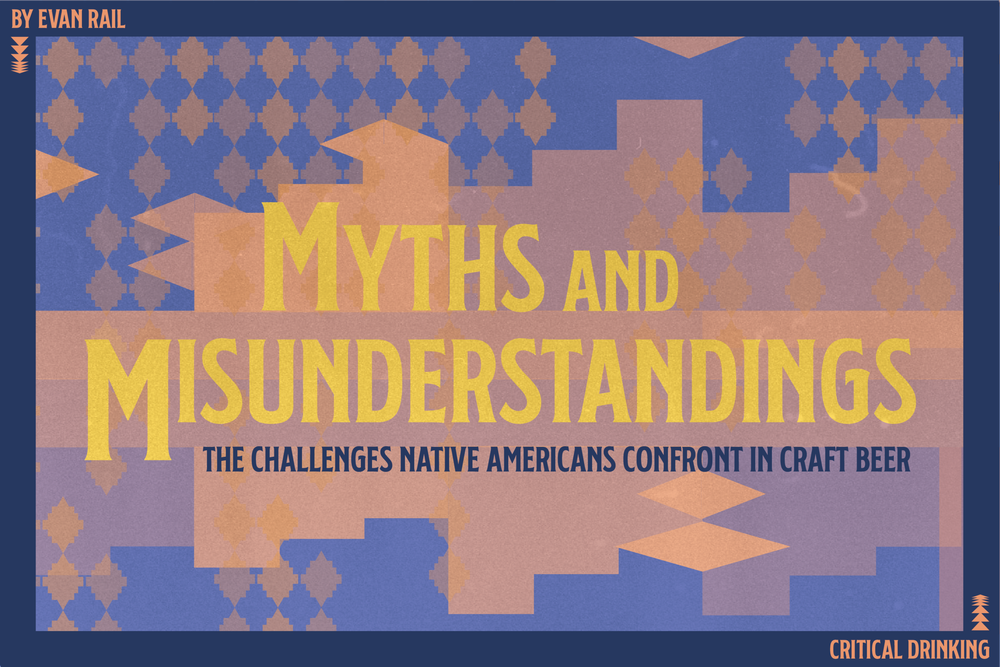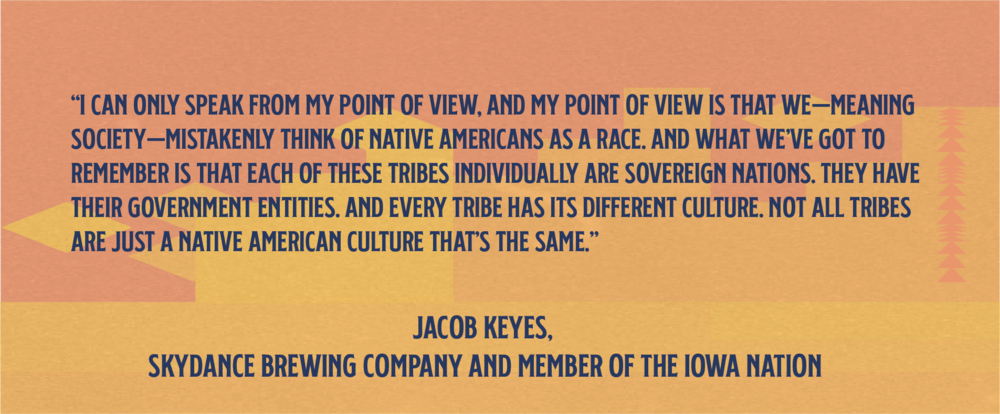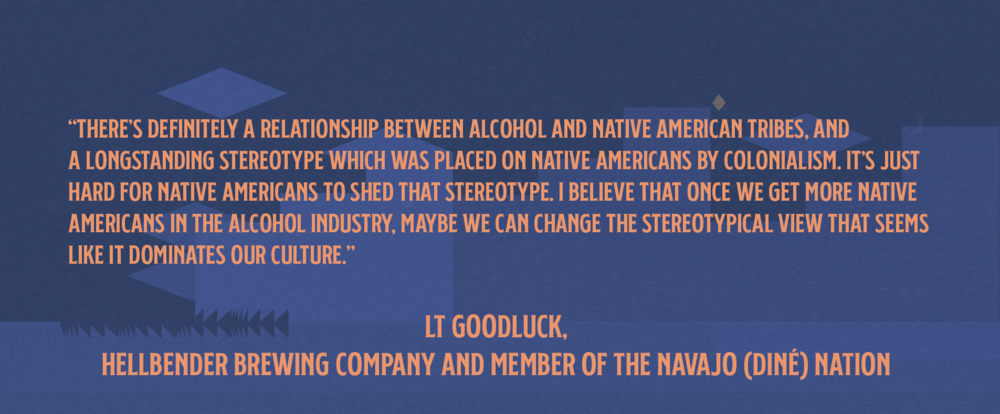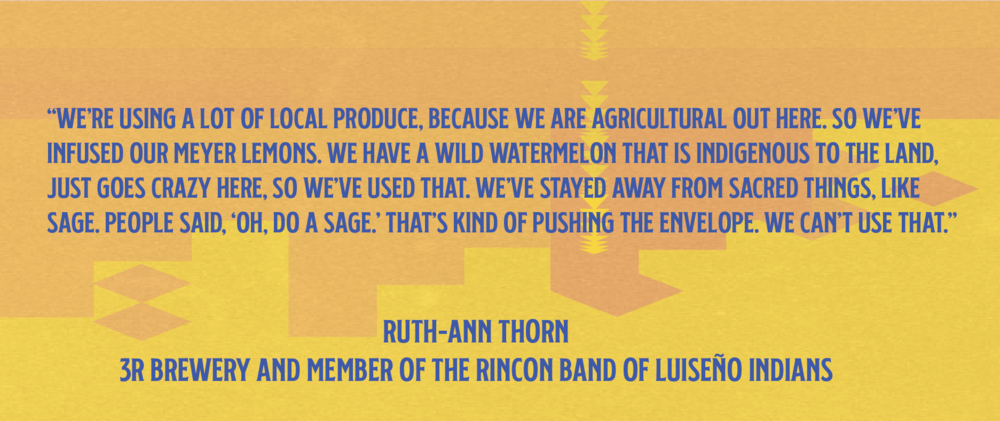
When it comes to the vibrant, rich, and diverse nature of Native American cultures, it often seems like it’s easier to get things wrong than to get things right. When it comes to Native Americans and the culture of beer, it’s even easier for outsiders to make mistakes.

I include myself in that equation, despite my own family background. My father was born and raised on the Choctaw Nation of Oklahoma and was an enrolled member of that tribe. His grandmother, a native speaker of Choctaw, was one of the roughly 100,000 Native Americans listed on the Dawes Rolls, a survey conducted by the U.S. Government to assign land rights to the Cherokee, Chickasaw, Choctaw, Creek, and Seminole tribes between 1898 and 1914. When I was growing up in California, my Oklahoma-born grandfather preferred to swear or say other bad words in Choctaw, rather than English, and he told me stories about his father’s experience brewing Choc Beer, one of our country’s original beer styles.
Because of my own closeness to—and, to be fair, generational distance from—that family history, I’ve been following the growth of Native American beer culture with interest for a long time. Over the past few years, I’ve spoken with a number of Native, Indigenous, and First Nations leaders in the beer and food worlds, often asking them what outsiders get wrong about Native cultures. The short answer: plenty.
But the good news is that we can see clear progress in every regard. Native American brewers and breweries are blossoming, despite the myriad challenges they face.
VARIED NATIONS AND CULTURES
Here’s an easy way people misunderstand Native Americans: They take a continent that is more than twice as large as Europe and reduce all the varied, vibrantly diverse groups of people on that vast and sprawling land mass to a single identity.
As Jacob Keyes, a member of the Iowa Nation and the owner of Skydance Brewing Company in Oklahoma City, points out, Native Americans are not just different from each other in linguistic, cultural, and historic terms. They’re legally distinct, too.
“I can only speak from my point of view, and my point of view is that we—meaning society—mistakenly think of Native Americans as a race,” Keyes says. “And what we’ve got to remember is that each of these tribes individually are sovereign nations. They have their government entities. And every tribe has its different culture. Not all tribes are just a Native American culture that’s the same.”
To put it another way: Most of us wouldn’t mistakenly believe that the Bulgarians and the Irish share a single language, history, or set of contemporary concerns, to take two sovereign nations from the European continent at random. Yet that’s exactly what we’re doing when we refer to Native Americans as a single them or they.

Plains Nations like the Arapaho and Kiowa used an extensive sign language in order to communicate, partly because of the diversity of the languages and cultures in that region alone. Beyond mere language, the many hundreds of indigenous nations across the continent have and had different lifestyles, cultures, belief systems, and systems of government. To think of all of those nations in North America as a single monolith is to believe, somehow, that the Bulgarians and the Irish are basically the same.
Not only are Indigenous North Americans incredibly varied in terms of languages, culture, government, and histories, but they’re geographically varied, too. Native people aren’t just present in Oklahoma, the Southwest, and on the Great Plains—they’re represented just about everywhere, including urban areas like New York City and craft beer capitals like San Diego, where Rincon Reservation Road Brewery (or 3R Brewery) recently became the first Native-American-owned brewery on tribal land in Southern California.
(MIS)REPRESENTATION
Despite that geographical range, achieving fair and equitable representation within the beer industry has proven tricky. Data, like the numbers in a recent survey by the Brewers Association, can often look overly optimistic, depending on where you stand.
Though “American Indian or Alaskan Native”—alone or in combination with another race—counted for just about 1.7% of all Americans in the 2010 Census, 2% of brewery managers reported that identity in the BA’s 2018 Brewery Operations Benchmarking Survey, with brewers reporting at 3% and brewery owners at 3.7%. Some 7% of the non-managerial brewery workers responding to the survey said that they were American Indian or Alaskan Native.
That might sound fine, but readers of fine print will point out that there were just 76 total responses—meaning 76 breweries—for the entire category of non-managerial brewery workers. Considering that the BA estimates that 140,000 people are employed directly at breweries and brewpubs, with over 7,000 working breweries in the U.S. in 2018, you might not want to put too much trust in what appears to be a very small sample size.
Moreover, those numbers do even less well against the recently released 2020 Census results, in which American Indian and Alaskan Native people counted for 2.9% of the total population.
But if that survey makes people think that the problem of equitable representation of Native Americans in the craft beer movement is not a terribly serious issue, they should look elsewhere. Specifically, they should look at labels. The Washington football team might have finally dropped its long-outdated and racist name, but there are still roughly 20 breweries on Untappd that have offered a fermented malt beverage called “redskin.” (Many of those are in Europe, where awareness of the offensive nature of that and other English-language slurs is often way behind the times.) Even more eye-popping: Several commercial beers are named after variations on the word “squaw,” an ethnic and sexual smear which the Merriam-Webster, American Heritage, and Oxford English dictionaries have all long defined as offensive. (This month, Secretary of the Interior Deb Haaland, our country’s first Native American to serve as a cabinet secretary, formally declared the word to be derogatory, ordering a task force to find replacements for the more than 650 geographic names that use that term.)
So while Native Americans are probably not putting in an outsize share of non-managerial hours in the brewhouse, they’ve certainly been better represented in terms of offensive names.
What’s more important to recognize is the small (but growing) and highly influential group of Native American-, First Peoples-, and Indigenous-owned and -run breweries that is currently emerging, many of which are making a real difference in terms of representation. In addition to SkyDance and 3R, there’s the standout Bow & Arrow Brewing Company in New Mexico, as well as Mad River Brewing Company in northern California, Broken Arrow Brewing Company in Oklahoma, Turtle Mountain Brewing Company in New Mexico, and 7 Clans Brewing in North Carolina, among others in the U.S., matched by producers like Kahnawake Brewing Company and Manitoulin Brewing Company in Canada.
Collectively, they represent a solid step forward for the industry. On Indigenous People’s Day, Bow & Arrow announced Native Land, a collaboration beer designed to acknowledge the contributions and history of Native Americans and benefit Native organizations. Native Land will be available from various participating breweries around the U.S. through March 2022.
EXPLODING THE FIREWATER MYTH
Call it the Firewater Myth: As the story goes, Native Americans just can’t handle alcohol, apparently because of their genetics.
This is an oft-repeated tale, and it’s a lie. Citing a large-scale epidemiological study published in “The Journal of Drug and Alcohol Dependence,” the American Addiction Center’s Alcohol.org website notes that this slur is simply not supported by scientific evidence.
“One of the most common stereotypes regarding the prevalence of alcohol abuse is the stereotype that Native Americans have higher rates of alcohol abuse and alcohol use disorders than other groups of individuals,” the site states. “Empirical research has determined over and over again that the stereotype is not supported by the data.”
Some data points from that survey:
Only 17.3% of Native Americans were empirically classified as heavy drinkers, compared to the overall average of 19.8% among all groups.
30% of Native Americans were classified as light to moderate drinkers, versus an overall average of 41.7% among all groups.
57.5% of Native Americans met the study’s definition for completely abstaining from alcohol, versus the overall average of 46.8% among all groups.
In other words, Native Americans statistically drink less than the average across all ethnic groups, and far more actually abstain from alcohol. And yet the stereotype remains.

A Navajo (or Diné) who grew up “on the reservation, nine miles west of Chinle, Arizona,” LT Goodluck is the brewer at Washington, D.C.’s Hellbender Brewing Company. In 2020, he received a surprising amount of online criticism—both from fellow Native Americans and others—over Hellbender Code Talker, a beer he brewed to honor his grandfather, a Navajo Code Talker during World War II. After the beer came out, various commenters on Facebook and elsewhere online accused Goodluck of doing “anything to make some money,” calling the beer “completely tacky,” “tone deaf,” and worse.
“There’s definitely a relationship between alcohol and Native American tribes, and a longstanding stereotype which was placed on Native Americans by colonialism,” Goodluck says. “It’s just hard for Native Americans to shed that stereotype. I believe that once we get more Native Americans in the alcohol industry, maybe we can change the stereotypical view that seems like it dominates our culture.”
Goodluck says that people need to look at things objectively, honestly, and positively.
“I do understand that there are problems with substance abuse with Native Americans, and also within every other culture. That’s definitely something we need to recognize. But we’re also better than that.”
While it’s not true that Native Americans have unique problems or a genetic tendency to misuse alcohol, alcohol abuse has certainly devastated many Native American communities, as Goodluck points out. As a result, many reservations today are dry, with bans on the sale or public consumption of alcohol.
But it’s important to remember that nothing happens in a vacuum—and that sometimes, some people are actually trying to make things worse. In 2012, the Oglala Sioux Tribe sued Anheuser-Busch, other industrial brewers, and the four high-volume liquor shops in the tiny, 10-person town of Whiteclay, Nebraska, over the oceans of beer that were flooding their neighboring dry Pine Ridge Reservation, with incoming volumes estimated at up to 13,000 cans each day. As The Guardian noted in a 2017 follow-up, Pine Ridge is also one of the poorest places in the country, with an estimated unemployment rate over 80%. Obviously, those two problems are not unrelated.
Ruth-Ann Thorn is the chairperson of the Rincon Band of Luiseño Indians’ Rincon Economic Development Corporation, which runs 3R Brewery on its tribal land. While acknowledging the problems of substance abuse among Native Americans, Thorn points to the vast array of other pressures Native people have experienced, even beyond poverty and unemployment.
“They faced complete and utter genocide,” she says. “They have had their land stripped from them, and they’ve been placed most of the time in a really bad area that nobody else wanted. When you have that type of a situation where you’ve stripped someone from the most important thing, which is their culture, and their ability to continue to prosper as a people, and you add alcohol to that mix, people are going to abuse it to escape.”
That kind of situation is certainly not exclusive to Native Americans, she notes.
“This is whether you look at any group of people. I mean, so to me, really, this whole idea of ‘Natives and alcohol, they don’t mix,’ to me, it’s really a prejudice. It’s something that should be removed.”
DUMPING THE MASCOTS
Even beyond slurs like “redskin” and “squaw,” Native American names, themes, and motifs have been appropriated for centuries by non-Native breweries. One of the most long-lasting of those, Leinenkugel’s “Indian Maiden” logo, was used for over 88 years before it was finally dumped in 2020. Beyond beer, the movement to drop Native American images and names as mascots is gaining momentum: In 2020, the Washington football team stopped using its previous name, while the former Cleveland Indians became the Cleveland Guardians after the 2021 baseball season. The State of Colorado instituted a new law requiring the elimination of Native American mascots for its state schools in 2021, while discussions are continuing for several schools with Native American mascots in Florida.
But not everyone recognizes that the appropriative use of someone else’s image, name, or culture by non-members is an outdated concept: After Leinenkugel’s announced its change, more than 4,000 fans signed an online petition asking the brewery to go back to the old logo.
While the heyday of strip-mining Native American culture for beer names and logos was clearly in the past, breweries in the craft era have still managed to step in it. After complaints from the American Indian Movement (AIM), Chicago’s Half Acre Beer Company announced that it would rebrand its award-winning Pale Ale as Senita in 2015; the beer’s previous name, Heyoka, is a word for a sacred contrarian or jester with an important ceremonial role for the Lakota and Dakota people.
In a way, it’s easy to understand the mistake: Pace the ever-moronic Rick Santorum, American culture has been built upon and deeply enriched by innumerable contributions from Native American culture, from our country’s most important agricultural crop, the corn plant, to the Iroquois Confederacy’s influence on the framing of the U.S. Constitution. Like the thousands of U.S. and Canadian place names that come from Native languages, it can be all too easy for outsiders to take other words, titles, and elements of Native culture for granted.
ANYTHING BUT NEWCOMERS
It should be pretty obvious that indigenous North Americans were the first brewers on this continent by many centuries, if not by multiple millennia: Archaeologists have even found 800-year-old evidence of alcoholic fermentation among the few Southwestern tribes that were mistakenly believed to have had no experience with alcohol until the arrival of the Spanish, despite being surrounded by other beer-making cultures. Sure, North America might be the home of C-hops and the land that launched the global craft beer movement, but this continent’s original styles are drinks like Tiswin, Choc Beer, and numerous variations on fermented maple sap. Lactose Stouts only showed up later.
LT Goodluck recounts a similar story from a Native friend from the West Coast.
“She was saying her tribe’s always had a beer or an alcoholic beverage,” he says. “So she’s pretty offended when white guys that came from Europe claim to have discovered beer, made beer, or refined beer. She was like, ‘Basically like every society since the beginning of time has had some sort of alcoholic drink, and don’t discount my Native American tribe from California.’”

Not only are Native Americans not newcomers to good beer, but the emerging generation of Native American brewers are successfully turning to their history for inspiration when they brew. In New Mexico, Bow & Arrow has used neomexicanus hops, a variety native to its state, in its beers, as well as New Mexico’s traditional blue corn. Similarly, Ruth-Ann Thorn says that her tribe’s long tradition of farming has inspired several of the recipes at 3R Brewery.
“We’re using a lot of local produce, because we are agricultural out here,” she says. “So we’ve infused our Meyer lemons. We have a wild watermelon that is indigenous to the land, just goes crazy here, so we’ve used that. We’ve stayed away from sacred things, like sage. People said, ‘Oh, do a sage.’ That’s kind of pushing the envelope. We can’t use that.” Future recipes, she says, might use other local ingredients like elderberry and prickly pear cactus—native and indigenous flavors that perfectly fit with the zeitgeist’s interest in brewing with local ingredients. No word on lactose at press time.
DEPTH BEYOND APPEARANCES
Many of the challenges facing Native Americans have deep roots in the past, from the hundreds of treaties that were broken by the U.S. government to the inauthentic way in which Native Americans have been historically depicted by the media well beyond beer labels and brewery paraphernalia. As Jacob Keyes points out, Native Americans don’t always look like how they’ve been portrayed by Hollywood or in advertisements.
“If you look at me, you’d think, ‘Oh, he’s like 1/64 Native American’ or whatever, but I’m half,” he says. “It goes back to ‘What’s the story?’ What’s the identity of Native Americans as seen through the eyes of non-Natives? And so somebody looks at me and they see lighter skin and they say, ‘Well, he doesn’t look Native.’ And then my response to that: ‘Well, what does an Indian look like?’ Everybody thinks they know what a Native American looks like because of what they saw on TV or in a movie.”
I feel this last point most personally: For all intents and purposes, and to go only by outward appearances, I am a white man, and I have most certainly benefited from that appearance throughout my life. But I am also my father’s son, and I carry his Choctaw history, tradition, and genetics forward with me.
To go by the results of the 2020 Census, more and more Americans now feel this way, a situation which could have a marked effect on Native American identity going forward. “The American Indian and Alaska Native alone population grew by 27.1%, and the American Indian and Alaska Native in combination population grew by 160% since 2010,” the Census announced this summer.
Those shifting numbers pair with much greater visibility of Native voices in the media. Just as Native Americans are working through the challenges facing them in the beer world, Native American filmmakers and writers like Chris Eyre, Sterlin Harjo, Georgina Lightning, and Lucas Brown Eyes, to name just a few, are working to depict authentic Native stories in TV and movies. Similarly, the Sioux Chef, Sean Sherman; “New Native Kitchen” author Freddie Bitsoie; and others in the food industry are changing historic misunderstandings about Native American foodways.
In short, this is a cultural shift that goes beyond the beer industry. And yes, it certainly could have taken place earlier in our history. But at least it’s finally happening now.

